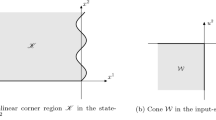Abstract.
In the present article we continue to develop the linear discrete time-invariant state/signal systems theory that we have introduced and studied in three earlier articles (Parts I—III). The trajectories of a state/signal system ∑ with a Hilbert state space χ and a Hilbert or Kreĭn signal space \({\mathcal{W}}\) consists of a pair of sequences (x(·),w(·)) which after an admissible input/output decomposition \({\mathcal{W}} = {\mathcal{Y}}\,\dot{+}\,{\mathcal{U}}\) of the signal space can be obtained from the set of trajectories (x(·), u(·), y(·)) of a standard input/state/output system by taking w(·) = y(·) + u(·). In Part I we studied the families of all admissible decompositions of W for a given state/signal system ∑ and the corresponding input/state/output representations and their transfer functions. Here we extend that theory to the the non-admissible case, and obtain generalized input/output transfer functions, as well as right and left affine transfer functions. As opposed to a standard transfer function, a generalized transfer function not need to be holomorphic at the origin. This makes it possible to realize a much larger class of transfer functions than what is possible by using the standard input/state/output theory. For example, every rational matrixvalued function (including those that have a pole at the origin) can be realized as the generalized transfer function of a state/signal system whose state space has a finite dimension equal to the McMillan degree of the given function. Likewise, every meromorphic J-contractive matrix-valued function can be realized as the generalized transfer function of a simple conservative state/signal system, or of a minimal passive state/signal system. Similar operator-valued results are also presented. As is well-known, a rational matrix-valued function with a pole at the origin can also be realized as the transfer function of a descriptor system, but this descriptor realization has the drawback that the dimension of its state space is bigger than the dimension of the state space of our s/s realization (i.e., bigger than the McMillan degree of the function). Our s/s realizations also differ significantly from other known realizations which depend on the choice of an auxiliary point in the complex plane where the given function is holomorphic.
Similar content being viewed by others
Author information
Authors and Affiliations
Corresponding author
Additional information
Communicated by Daniel Alpay.
Dedicated to the memory of Mark Grigorevich Kreĭn.
Damir Z. Arov thanks Åbo Akademi for its hospitality and the Academy of Finland and the Magnus Ehrnrooth Foundation for their financial support during his visits to Åbo in 2003–2006.
Received: November 4, 2006. Accepted: April 8, 2007.
Rights and permissions
About this article
Cite this article
Arov, D.Z., Staffans, O.J. State/Signal Linear Time-Invariant Systems Theory, Part IV: Affine and Generalized Transfer Functions of Discrete Time Systems. Complex anal.oper. theory 1, 457–521 (2007). https://doi.org/10.1007/s11785-007-0033-y
Published:
Issue Date:
DOI: https://doi.org/10.1007/s11785-007-0033-y




